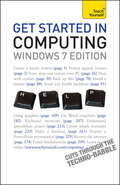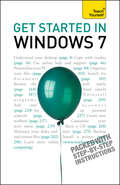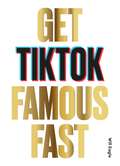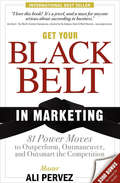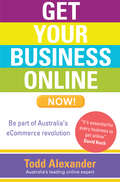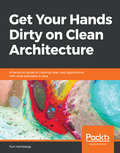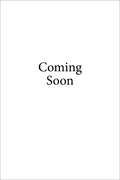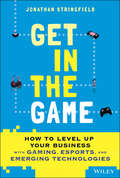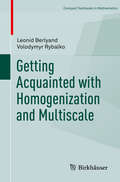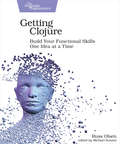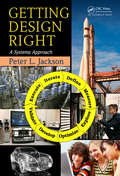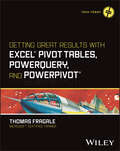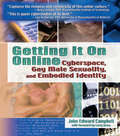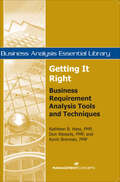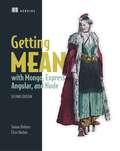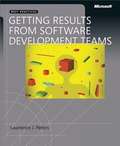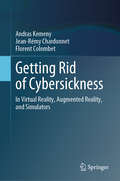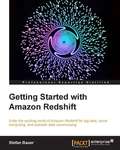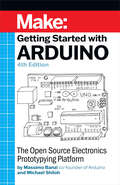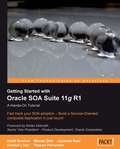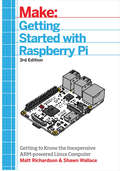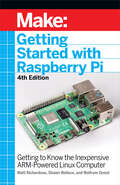- Table View
- List View
Get Started In Computing: Teach Yourself (Ty Computing Ser.)
by Moira StephenGet Started in Computing is perfect for any new computer user who wants to get up and running quickly and simply. If you are a beginner it is a cost-effective alternative to buying an expensive manual for each application. Though Written for the general user, you will also find the level and content relevant if you are following MOUS certification, SQA modules and BCS Level 1/2 application courses.With step-by-step instructions, minimal jargon and detailed explanations of all the technical terms, this book will give you the confidence to move forward and expand your knowledge. Updated for Windows 7, the book covers all the basics, helping you to find ways of using your computer to suit you. Also included:- Health and safety laws and guidelines affecting the use of IT- Creating and maintaining a safe workstation environment- MS Office interface - ribbon, tabs, groups, MSO button and menu, Quick Access toolbar- Advantages and disadvantages of different email systems- Netiquette- Hidden dangers - unsolicited email, virus dangersNOT GOT MUCH TIME?One and five-minute introductions to key principles to get you started.AUTHOR INSIGHTSLots of instant help with common problems and quick tips for success, based on the author's many years of experience.TEST YOURSELFTests in the book and online to keep track of your progress.EXTEND YOUR KNOWLEDGEExtra online articles at www.teachyourself.com to give you a richer understanding of the basics of computing.FIVE THINGS TO REMEMBERQuick refreshers to help you remember the key facts.TRY THISInnovative exercises illustrate what you've learnt and how to use it.
Get Started in Windows 7: An absolute beginner's guide to the Windows 7 operating system
by Mac BrideGet Started in Windows 7 explains all the key aspects of this operating system from the user's angle including:- running programs and managing files- getting online- managing your email- maintaining your system- configuring printers- customising your system.- getting help- using accessoriesWritten for the new user at home or in the office it covers all the key features of Windows 7 and helps you maximise your use of the system with confidence.NOT GOT MUCH TIME?One and five-minute introductions to key principles to get you started.AUTHOR INSIGHTSLots of instant help with common problems and quick tips for success, based on the author's many years of experience.TEST YOURSELFTests in the book and online to keep track of your progress.EXTEND YOUR KNOWLEDGEExtra online articles at www.teachyourself.com to give you a richer understanding of Windows 7.FIVE THINGS TO REMEMBERQuick refreshers to help you remember the key facts.TRY THISInnovative exercises illustrate what you've learnt and how to use it.
Get Started in Windows 7: An absolute beginner's guide to the Windows 7 operating system
by Peter MacBrideGet Started in Windows 7 explains all the key aspects of this operating system from the user's angle including:- running programs and managing files- getting online- managing your email- maintaining your system- configuring printers- customising your system.- getting help- using accessoriesWritten for the new user at home or in the office it covers all the key features of Windows 7 and helps you maximise your use of the system with confidence.NOT GOT MUCH TIME?One and five-minute introductions to key principles to get you started.AUTHOR INSIGHTSLots of instant help with common problems and quick tips for success, based on the author's many years of experience.TEST YOURSELFTests in the book and online to keep track of your progress.EXTEND YOUR KNOWLEDGEExtra online articles at www.teachyourself.com to give you a richer understanding of Windows 7.FIVE THINGS TO REMEMBERQuick refreshers to help you remember the key facts.TRY THISInnovative exercises illustrate what you've learnt and how to use it.
Get Started on Android with TalkBack 12.2
by Bookshare IndiaThis is a complete guide for using 'Talkback' with android devices. it It explains in details the various options offered to Blind and Low vision users for using the 'Talkback' screen reader for optimum use of their android devices.
Get TikTok Famous Fast
by Will EagleGrab your phone and your friends and start making fame-worthy content today!Get TikTok Famous Fast is a bite-sized guide to building your own empire on TikTok and using it as a launchpad for your personal brand and media career.Top TikTok stars and industry insiders provide their tips on how be a hit, how to make your content the best possible, how to tap into the latest memes and trends, how to edit and - most importantly - how to grow your following.
Get TikTok Famous Fast
by Will EagleGrab your phone and your friends and start making fame-worthy content today!Get TikTok Famous Fast is a bite-sized guide to building your own empire on TikTok and using it as a launchpad for your personal brand and media career.Top TikTok stars and industry insiders provide their tips on how be a hit, how to make your content the best possible, how to tap into the latest memes and trends, how to edit and - most importantly - how to grow your following.
Get Your Black Belt in Marketing: 81 Power Moves to Outperform, Outmaneuver, and Outsmart the Competition
by Ali PervezIncrease revenues quickly with the ideas in this international bestseller: &“I love this book!&” —Joe Girard Are you looking for proven revenue-generating strategies to grow your sales immediately? In Get Your Black Belt in Marketing, you&’ll learn eighty-one moves to cut through the marketing clutter. Covering such topics as building quality relationships; creating and working your database; the three ways to grow sales and the three types of customers; establishing a brand, and much more, these fast, effective moves can make you a master at marketing. &“A must for anyone serious about succeeding in business.&” —Joe Girard, named &“World&’s Greatest Salesman&” by the Guinness Book of World Records
Get Your Business Online Now!
by Todd AlexanderOnline business, or e-commerce, has become the buzzword of the past year. The media and key influencers alike are talking about the potential of e-commerce but many Australian businesses have not reached their potential and those managing them don?t know how to go about it. One of the obstacles is the lack of affordable, local knowledge in the area. The assumption is that anyone with a website can appear on Google and be successful - but the reality is vastly different. Consultants will charge tens of thousands of dollars to give the same advice that is contained in this book, which includes an outline of the e-commerce opportunity, how to design and build an effective website, the best marketing and advertising strategies, logistics and payment solutions, utilising marketplaces and mobile commerce, and the key to outstanding online customer service. In this straightforward user-friendly guide, Todd Alexander, an author with 10 years? experience as an e-commerce expert, provides the essential tools to get all types of businesses get online and make their websites successful and profitable.
Get Your Hands Dirty on Clean Architecture: A hands-on guide to creating clean web applications with code examples in Java
by Tom HombergsGain insight into how hexagonal architecture can help to keep the cost of development low over the complete lifetime of an application Key Features Explore ways to make your software flexible, extensible, and adaptable Learn new concepts that you can easily blend with your own software development style Develop the mindset of building maintainable solutions instead of taking shortcuts Book Description We would all like to build software architecture that yields adaptable and flexible software with low development costs. But, unreasonable deadlines and shortcuts make it very hard to create such an architecture. Get Your Hands Dirty on Clean Architecture starts with a discussion about the conventional layered architecture style and its disadvantages. It also talks about the advantages of the domain-centric architecture styles of Robert C. Martin's Clean Architecture and Alistair Cockburn's Hexagonal Architecture. Then, the book dives into hands-on chapters that show you how to manifest a hexagonal architecture in actual code. You'll learn in detail about different mapping strategies between the layers of a hexagonal architecture and see how to assemble the architecture elements into an application. The later chapters demonstrate how to enforce architecture boundaries. You'll also learn what shortcuts produce what types of technical debt and how, sometimes, it is a good idea to willingly take on those debts. After reading this book, you'll have all the knowledge you need to create applications using the hexagonal architecture style of web development. What you will learn Identify potential shortcomings of using a layered architecture Apply methods to enforce architecture boundaries Find out how potential shortcuts can affect the software architecture Produce arguments for when to use which style of architecture Structure your code according to the architecture Apply various types of tests that will cover each element of the architecture Who this book is for This book is for you if you care about the architecture of the software you are building. To get the most out of this book, you must have some experience with web development. The code examples in this book are in Java. If you are not a Java programmer but can read object-oriented code in other languages, you will be fine. In the few places where Java or framework specifics are needed, they are thoroughly explained.
Get a Job, Creep: The Creeper Diaries, An Unofficial Minecrafters Novel, Book Ten (The Creeper Diaries #10)
by Greyson MannWhen Gerald’s parents decide it’s time for him to learn the value of an emerald, he sets out to get the perfect summer job. Wolf-walking, anyone? Baby-zombie-sitting? Llama grooming? Gerald isn’t exactly loving his options. When his mom starts selling vitamins and minerals, Gerald comes up with a sales idea of his own—a BIG idea. But he’s going to need some help. After he hires a few friends, they start raking in the emeralds. Gerald is going to be rich! He can see it already! But his fortune might come with a pretty big price tag, too.
Get in the Game: How to Level Up Your Business with Gaming, Esports, and Emerging Technologies
by Jonathan StringfieldAn essential guide for marketers and execs wishing to integrate their brands with modern games and esports In Get in the Game: How to Level Up Your Business with Gaming, Esports, and Emerging Technologies, decorated gaming and social media research and marketing executive Jonathan Stringfield delivers a roadmap to understanding and navigating marketing and business integrations into the gaming ecosystem: who plays games (and why), how modern games are created and oriented around the world of esports, and where brands can get involved with modern games. This book explains the breadth and depth of the gaming audience, describing the rapidly changing demographics of modern games and the various motivations gamers have for playing games. It also unpacks the history of gaming and how it has impacted the creative processes and output from the industry. Finally, it offers a practical guide for brands wishing to integrate themselves into new gaming environments, with an emphasis on maximizing success for marketers, developers, content creators, and fans. Get in the Game provides: A thorough introduction to why marketers and executives must pay closer attention to gaming, as well as existing roadblocks to understanding the gaming industry Comprehensive explorations of the psychology and motivations of gaming, and implications towards messaging and brand safety. Practical discussions of gaming as a competitive platform or streaming viewing experience. In-depth examinations of gaming ad placements, deep marketing integrations between companies and games, and future directions for the industry and how it relates to the emergence of the metaverse.Perfect for marketing strategists, brand managers, and Chief Marketing Officers, Get in the Game will also earn a place in the libraries of executives seeking to connect with the misunderstood yet largest segment in consumer entertainment.
Getting Acquainted with Homogenization and Multiscale (Compact Textbooks in Mathematics)
by Leonid Berlyand Volodymyr RybalkoThe objective of this book is to navigate beginning graduate students in mathematics and engineering through a mature field of multiscale problems in homogenization theory and to provide an idea of its broad scope. An overview of a wide spectrum of homogenization techniques ranging from classical two-scale asymptotic expansions to Gamma convergence and the rapidly developing field of stochastic homogenization is presented. The mathematical proofs and definitions are supplemented with intuitive explanations and figures to make them easier to follow. A blend of mathematics and examples from materials science and engineering is designed to teach a mixed audience of mathematical and non-mathematical students.
Getting Clojure: Build Your Functional Skills One Idea at a Time
by Russ OlsenBehind every programming language lies a vision of how programs should be built. The vision behind Clojure is of a radically simple language framework holding together a sophisticated collection of programming features. Learning Clojure involves much more than just learning the mechanics of the language. To really get Clojure you need to understand the ideas underlying this structure of framework and features. You need this book: an accessible introduction to Clojure that focuses on the ideas behind the language as well as the practical details of writing code. Clojure attracts developers on the cutting edge and is arguably the best language for learning to program in the functional style without compromise. But this comes with a steep learning curve. Getting Clojure directly addresses this by teaching you how to think functionally as it teaches you the language. You'll learn about Clojure's powerful data structures and high-level functions, but you'll also learn what it means for a language to be functional, and how to think in Clojure's functional way.Each chapter of Getting Clojure takes a feature or two or three from the language, explains the syntax and the mechanics behind that feature so that you can make it work before digging into the deeper questions: What is the thinking behind the feature? And how does it fit in with the rest of the language? In Getting Clojure you'll learn Clojure's very simple syntax, but you'll also learn why that syntax is integral the way the language is constructed. You'll discover that most data structures in Clojure are immutable, but also why that leads to more reliable programs. And you'll see how easy it is to write Clojure functions and also how you can use those functions to build complex and capable systems.With real-world examples of how working Clojure programmers use the language, Getting Clojure will help you see the challenges of programming through the eye of experienced Clojure developers.What You Need:You will need to some background in programming. To follow along with the examples in the book, you will need Java 6 or new, Clojure 1.8 or 1.9, and Leiningen 2.
Getting Design Right: A Systems Approach
by Peter L. JacksonFilling a new need in engineering education, Getting Design Right: A Systems Approach integrates aspects from both design and systems engineering to provide a solid understanding of the fundamental principles and best practices in these areas. Through examples, it encourages students to create an initial product design and project plan.Classroom-te
Getting Great Results with Excel Pivot Tables, PowerQuery and PowerPivot (Tech Today)
by Thomas FragaleGet more out of your data with step-by-step tutorials for the Excel features you need to know Excel is still the most popular tool for organizing and analyzing data, and today's professionals are expected to have a high degree of fluency with it. Complex Excel tools like Pivot Tables, PowerQuery, and PowerPivot can help you manage and report on data the way you need to. Getting Great Results with Excel Pivot Tables, PowerQuery and PowerPivot offers a fresh look at how these tools can help you. Author and Microsoft Certified Trainer Thomas Fragale breaks down the topics into easy-to-use steps and screenshots, so you'll be able to put your advanced Excel skills into practice right away. Using Pivot Tables, PowerQuery, and PowerPivot, you can import, sort, transform, summarize, and present your data, all without having to be a programmer. This book takes the technical jargon out of using these features, so you can do your job more efficiently, bring value to your teams, and advance your career. The plain-English instructions inside will help anyone learn to get quick, meaningful results from your data, without having a degree in computing. Get easy-to-understand walkthroughs for analyzing data and creating dashboards in Microsoft Excel Learn how to organize data in Excel and use advanced features to find patterns and insights Summarize any kind of data faster and easier, leaving you more time for other tasks Turn raw numbers into new knowledge, reports, and charts that tell coworkers and customers what they need to know This book is great for anybody who has tons of raw data and needs to make sense of it. Managers, salespeople, finance professionals, marketers—along with anyone else who works with large amounts of data—will love this quick and easy guide to Pivot Tables, PowerQuery, and PowerPivot.
Getting It On Online: Cyberspace, Gay Male Sexuality, and Embodied Identity
by John Edward CampbellLearn how gay men use Internet technologies to connect with others sharing their erotic desires and to forge affirming communities online! Getting It On Online: Cyberspace, Gay Male Sexuality, and Embodied Identity examines the online embodied experiences of gay men. At once scholarly and sensual, this unique book is the result of a three-year ethnographic study chronicling the activities on three distinct social scenes in the world of Internet Relay Chat (IRC)-virtual spaces constructed by gay men for the erotic exploration of the male body. Examining the vital role the body plays in defining these online spaces offers insight into how gay men negotiate their identities through emerging communication technologies. The author combines a critical look at the role of the body in cyberspace with candid accounts of his own online experiences to challenge conventional views on sex, sexuality, and embodied identity. Getting It On Online provides an inside look at three specific online communities-gaychub (a community celebrating male obesity), gaymuscle (a community formulated around images of the muscular male body), and gaymusclebears (a space representing the erotic convergence of the obese and muscular male bodies emerging out of the gay male "bear" subculture)-in an effort to unsettle those models of beauty and the erotic depicted in more mainstream media. The book demonstrates how the social position of these men in the physical world in regards to age, race, gender, class, and physical beauty influences their online experiences. Far from a realm of bodiless exultation, Getting It On Online illustrates how the flesh remains very much present in cyberspace. Getting It On Online examines topics such as: why people chat online the history of IRC (Internet Relay Chat) how people construct their identities in cyberspace how some online spaces function like virtual gay bars the concept of online disembodiment the role the body plays in online social relations the future of online communication ethnographic research in cyberspace mediated images of the male body and the gay male beauty myth and much more! Getting It On Online: Cyberspace, Gay Male Sexuality, and Embodied Identity is an essential resource for anthropologists, sociologists, and psychologists; academics working in gender studies, queer theory, cultural studies, and cyber-culture studies; and anyone interested in gay and lesbian issues and/or cyberspace.
Getting It Right: Business Requirement Analysis Tools and Techniques
by Kevin Brennan Don Wessels Kathleen B HassVolume of the Business Analysis Essential Library SeriesGetting It Right: Business Requirement Analysis Tools and Techniques, presents principles and practices for effective requirements analysis and specification, and a broad overview of the requirements analysis and specification processes. This critical reference is designed to help the business analyst decide which requirement artifacts should be produced to adequately analyze requirements. Examine the complete spectrum of business requirement analysis from preparation through documentation. Learn the steps in the analysis and specification process, as well as, how to choose the right requirements analysis techniques for your project.
Getting MEAN with Mongo, Express, Angular, and Node
by Simon Holmes clive harberSummaryGetting MEAN, Second Edition teaches you how to develop full-stack web applications using the MEAN stack. This edition was completely revised and updated to cover MongoDB 4, Express 4, Angular 7, Node 11, and the latest mainstream release of JavaScript ES2015.Purchase of the print book includes a free eBook in PDF, Kindle, and ePub formats from Manning Publications.About the TechnologyJuggling languages mid-application can radically slow down a full-stack web project. The MEAN stack—MongoDB, Express, Angular, and Node—uses JavaScript end to end, maximizing developer productivity and minimizing context switching. And you'll love the results! MEAN apps are fast, powerful, and beautiful.About the BookGetting MEAN, Second Edition teaches you how to develop full-stack web applications using the MEAN stack. Practical from the very beginning, the book helps you create a static site in Express and Node. Expanding on that solid foundation, you'll integrate a MongoDB database, build an API, and add an authentication system. Along the way, you'll get countless pro tips for building dynamic and responsive data-driven web applications! What's insideMongoDB 4, Express 4, Angular 7, and Node.js 11MEAN stack architectureMobile-ready web appsBest practices for efficiency and reusabilityAbout the ReaderReaders should be comfortable with standard web application designs and ES2015-style JavaScript.About the AuthorSimon Holmes and Clive Harber are full-stack developers with decades of experience in JavaScript and other leading-edge web technologies.Table of ContentsPART 1 - SETTING THE BASELINEIntroducing full-stack developmentDesigning a MEAN stack architecturePART 2 - BUILDING A NODE WEB APPLICATIONCreating and setting up a MEAN projectBuilding a static site with Node and ExpressBuilding a data model with MongoDB and MongooseWriting a REST API: Exposing the MongoDB database to the applicationConsuming a REST API: Using an API from inside ExpressPART 3 - ADDING A DYNAMIC FRONT END WITH ANGULARCreating an Angular application with TypeScriptBuilding a single-page application with Angular: FoundationsBuilding a single-page application with Angular: The next levelPART 4 - MANAGING AUTHENTICATION AND USER SESSIONSAuthenticating users, managing sessions, and securing APIsUsing an authentication API in Angular applications
Getting Results from Software Development Teams
by Lawrence J. PetersLearn best practices for software development project management--and lead your teams and projects to success. Dr. Lawrence Peters is an industry-recognized expert with decades of experience conducting research and leading real-world software projects. Beyond getting the best developers, equipment, budget, and timeline possible--Peters concludes that no factor is more critical to project success than the manager's role. Drawing on proven practices from allied industries such as business, psychology, accounting, and law, he describes a broader project-management methodology--with principles that software managers can readily adapt to help increase their own effectiveness and the productivity of their teams. Unlike other books on the topic, this book focuses squarely on the manager--and shows how to get results without adopting philosophies from Genghis Khan or Machiavelli. (There is mention of Godzilla, however.) Packed with real-world examples and pragmatic advice, this book shows any software development manager--new or experienced--how to lead teams in delivering the right results for their business.
Getting Rid of Cybersickness: In Virtual Reality, Augmented Reality, and Simulators
by Andras Kemeny Jean-Rémy Chardonnet Florent ColombetThis book provides a concise overview of VR systems and their cybersickness effects, giving a description of possible reasons and existing solutions to reduce or avoid them. Moreover, the book explores the impact that understanding how efficiently our brains are producing a coherent and rich representation of the perceived outside world would have on helping VR technics to be more efficient and friendly to use.Getting Rid of Cybersickness will help readers to understand the underlying technics and social stakes involved, from engineering design to autonomous vehicle motion sickness to video games, with the hope of providing an insight of VR sickness induced by the emerging immersive technologies. This book will therefore be of interest to academics, researchers and designers within the field of VR, as well as industrial users of VR and driving simulators.
Getting Started With Amazon Redshift
by Stefan BauerGetting Started With Amazon Redshift is a step-by-step, practical guide to the world of Redshift. Learn to load, manage, and query data on Redshift.This book is for CIOs, enterprise architects, developers, and anyone else who needs to get familiar with RedShift. The CIO will gain an understanding of what their technical staff is working on; the technical implementation personnel will get an in-depth view of the technology, and what it will take to implement their own solutions.
Getting Started With Arduino: The Open Source Electronics Prototyping Platform
by Massimo Banzi Michael ShilohArduino is the open source electronics prototyping platform that has taken the Maker Movement by storm. This thorough introduction, updated for the latest Arduino release, helps you start prototyping right away. From obtaining the required components to putting the final touches on your project, all the information you need is here!Getting started with Arduino is a snap. To use the introductory examples in this guide, all you need is an Arduino Uno or Leonardo, along with a USB cable and an LED. The easy-to-use, free Arduino development environment runs on Mac, Windows, and Linux.In Getting Started with Arduino, you'll learn about:Interaction design and physical computingThe Arduino board and its software environmentBasics of electricity and electronicsPrototyping on a solderless breadboardDrawing a schematic diagramTalking to a computer--and the cloud--from ArduinoBuilding a custom plant-watering system
Getting Started With Oracle SOA Suite 11g R1 – A Hands-On Tutorial
by Demed L'Her Heidi BuelowThis fully illustrated step-by-step tutorial is based on proven training material that has been highly praised by hundreds of developers in product training courses given as part of the SOA Suite 11g rollout. You will learn how to build a services-oriented composite application project iteratively with each chapter introducing new technology components and adding a functional increment. Each chapter comes with a working solution for your reference. You can use the solution to start the tutorial at any point or to jump around to the chapters that most interest you. This clear and detailed tutorial is perfect for both new and experienced SOA developers looking for a pragmatic and hands-on approach to learning Oracle SOA Suite 11g.
Getting Started With Raspberry Pi: An Introduction to the Fastest-Selling Computer in the World
by Shawn Wallace Matt RichardsonThe Raspberry Pi is a credit card-sized computer that plugs into your TV and a keyboard. It is a capable little computer which can be used in electronics projects, and for many of the things that your desktop PC does, like spreadsheets, word processing, browsing the internet, and playing games. It also plays high-definition video. This book takes you step-by-step through many fun and educational possibilities. Take advantage of several preloaded programming languages. Use the Raspberry Pi with Arduino. Create Internet-connected projects. Play with multimedia. With Raspberry Pi, you can do all of this and more.
Getting Started With Raspberry Pi: Getting to Know the Inexpensive ARM-Powered Linux Computer
by Shawn Wallace Matt Richardson Wolfram DonatThe Raspberry Pi is a credit card-sized computer that plugs into your TV and a keyboard. It is a capable little computer which can be used in electronics projects, and for many of the things that your desktop PC does, like spreadsheets, word processing, browsing the internet, and playing games. It also plays high-definition video. This book takes you step-by-step through many fun and educational possibilities. Take advantage of several preloaded programming languages. Use the Raspberry Pi with Arduino. Create Internet-connected projects. Play with multimedia. With Raspberry Pi, you can do all of this and more.
